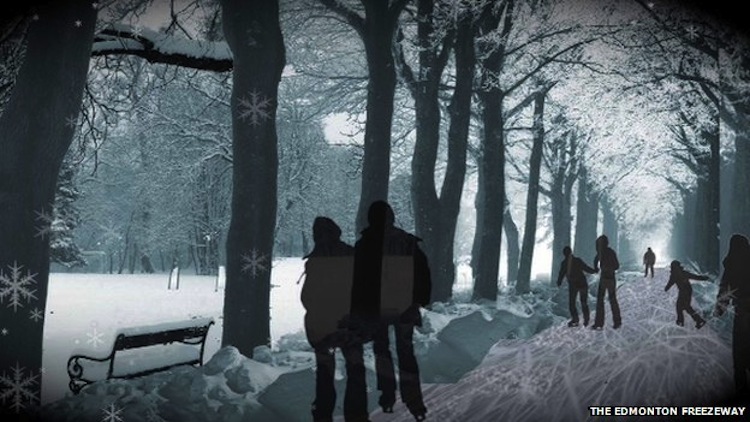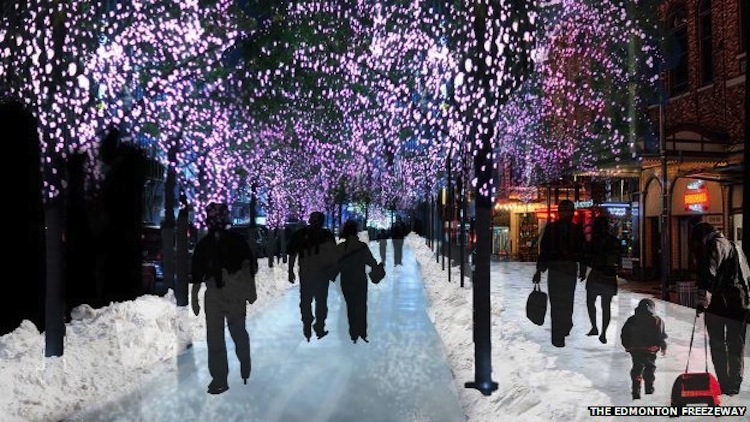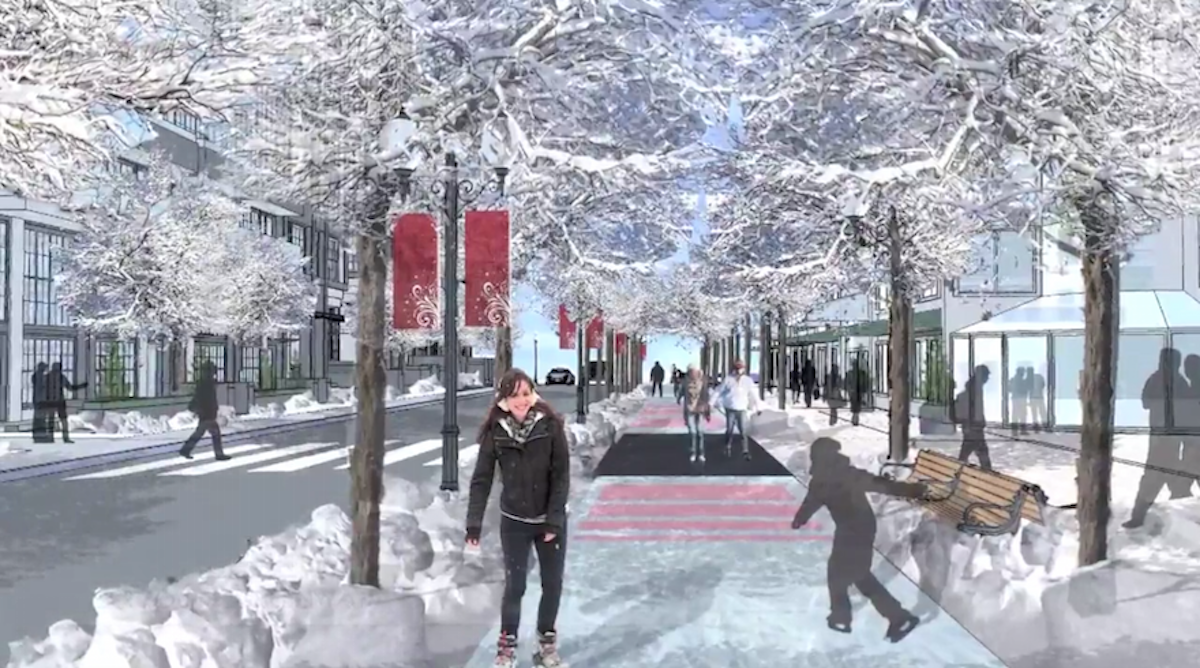When cities such as Edmonton, Canada, are below freezing for the majority of the year, it's hard to want to embrace the cold and snow. However, landscape architecture student Matthew Gibbs and city council members are considering a way to encourage residents to enjoy the cold rather than try to hide from it. According to BBC, the city is pondering the idea of a "Freezeway" and may launch a pilot project as early as next winter.
The idea was first brought up during a city council meeting during the 1990s, when a council member made an off-hand comment that suggested opening the fire hydrants and letting the streets flood and freeeze over. The comment inspired Gibbs to design the Freezeway, which won first place at the 2013 COLDSCAPES international design competition.
Gibbs said that if two existing rail corridors were connected, then an 11-km route could be established to allow people to skate to work, school, or events in the city. The Freezeway would also encourage more active lifestyles during the winter months, said Gibbs.
Design plans for the Freezeway include:
- Setting up skate rentals in nearby metro stops
- Using buildings as windbreaks
- Using "curbside skating lanes" that could be rolled up in the spring
- Providing built-in snow storage to serve as traffic dividers and contain the ice
- Building developments and plazas in sunny areas
Many council members have said the Freezeway is a good idea, and could be financed with corporate sponsorship or crowdsourcing. The price tag would be hefty, however, at as much as $400 per meter.



Related Stories
| Aug 11, 2010
AASHE releases annual review of sustainability in higher education
The Association for the Advancement of Sustainability in Higher Education (AASHE) has announced the release of AASHE Digest 2008, which documents the continued rapid growth of campus sustainability in the U.S. and Canada. The 356-page report, available as a free download on the AASHE website, includes over 1,350 stories that appeared in the weekly AASHE Bulletin last year.
| Aug 11, 2010
Girl Scouts of San Jacinto Council Program Place Project
Houston, Texas
The Girl Scouts of San Jacinto Council Program Place is the headquarters for the largest Girl Scout Council in the U.S., with 63,000 scouts. The building houses the council’s administrative offices, a Girl Scout museum, and activity space. When an adjacent two-story office building became available, the council jumped at the chance to expand its museum and program space.
| Aug 11, 2010
Burt Hill, HOK top BD+C's ranking of the nation's 100 largest university design firms
A ranking of the Top 100 University Design Firms based on Building Design+Construction's 2009 Giants 300 survey. For more Giants 300 rankings, visit http://www.BDCnetwork.com/Giants
| Aug 11, 2010
PBK, DLR Group among nation's largest K-12 school design firms, according to BD+C's Giants 300 report
A ranking of the Top 75 K-12 School Design Firms based on Building Design+Construction's 2009 Giants 300 survey. For more Giants 300 rankings, visit http://www.BDCnetwork.com/Giants
| Aug 11, 2010
Turner Building Cost Index dips nearly 4% in second quarter 2009
Turner Construction Company announced that the second quarter 2009 Turner Building Cost Index, which measures nonresidential building construction costs in the U.S., has decreased 3.35% from the first quarter 2009 and is 8.92% lower than its peak in the second quarter of 2008. The Turner Building Cost Index number for second quarter 2009 is 837.
| Aug 11, 2010
AGC unveils comprehensive plan to revive the construction industry
The Associated General Contractors of America unveiled a new plan today designed to revive the nation’s construction industry. The plan, “Build Now for the Future: A Blueprint for Economic Growth,” is designed to reverse predictions that construction activity will continue to shrink through 2010, crippling broader economic growth.
| Aug 11, 2010
Section Eight Design wins 2009 Open Architecture Challenge for classroom design
Victor, Idaho-based Section Eight Design beat out seven other finalists to win the 2009 Open Architecture Challenge: Classroom, spearheaded by the Open Architecture Network. Section Eight partnered with Teton Valley Community School (TVCS) in Victor to design the classroom of the future. Currently based out of a remodeled house, students at Teton Valley Community School are now one step closer to getting a real classroom.







